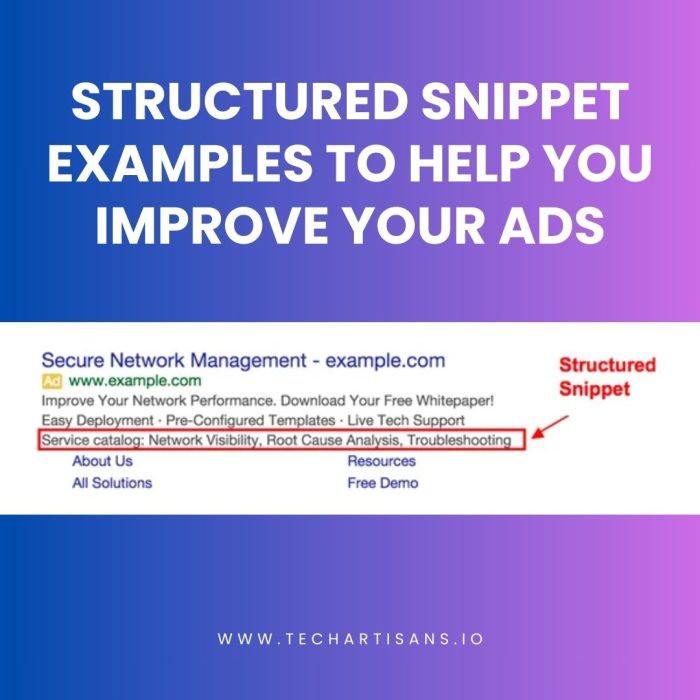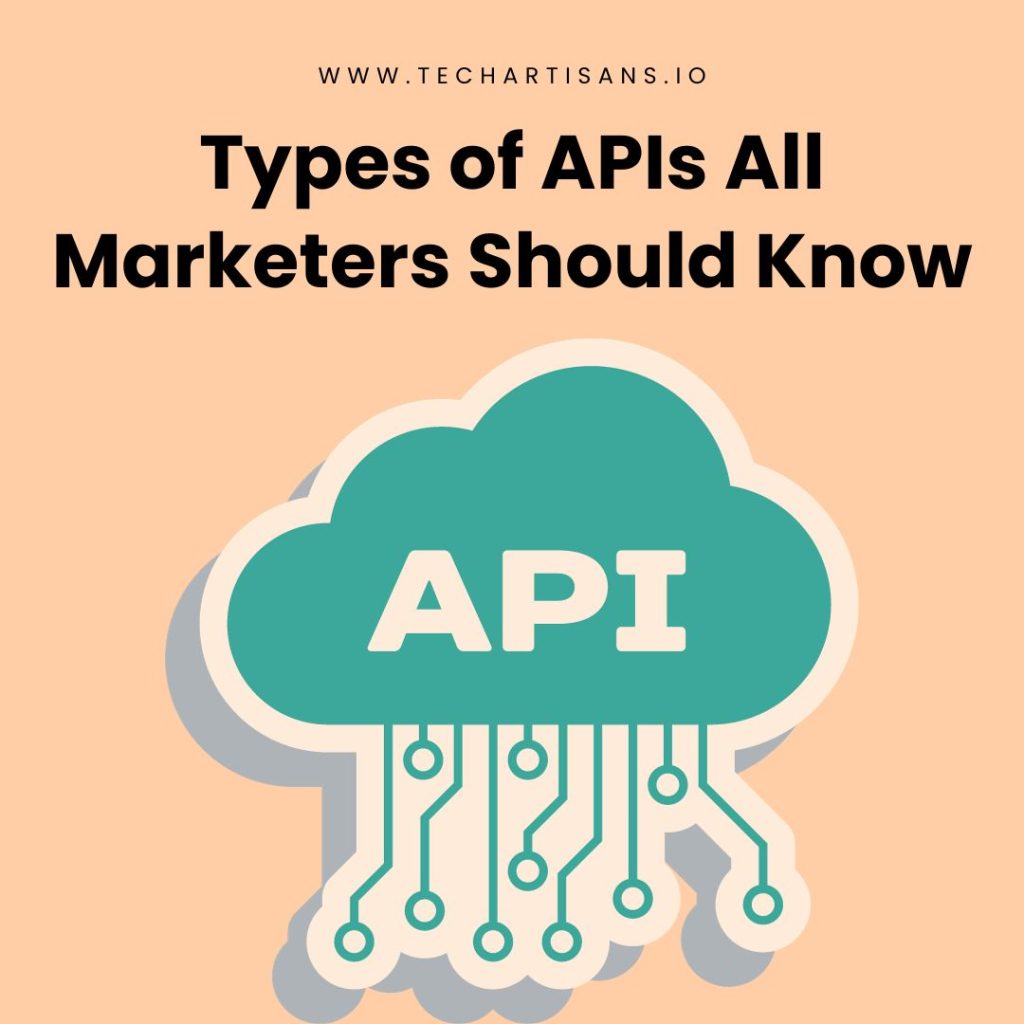In digital marketing, structured snippets are a game-changer, especially for small to medium-sized businesses. These nifty tools can seriously amp up your advertising game. In this blog, we will explore various structured snippet examples that can supercharge your ad performance, make your business more visible, and ultimately boost your profits. Let’s dive into the world of structured snippets and turn your average ads into something truly exceptional.
What are Structured Snippets?
Structured snippets are like powerful tools that can make a big difference in online advertising. They make Google Ads better by adding more useful information. But what are these tools, and how can they make your small to medium-sized business ads even better? Let’s take a closer look to understand their potential.
How They Differ from Regular Ad Text
Structured snippets are not like the regular text you see in ads that talk about the promotion. Instead, they give extra details that go along with your ad text, providing more specific information about what your business offers. This extra information makes your ad more relevant and increases the chances of getting the attention of potential customers.
Importance In Grabbing More Ad Real Estate
Structured snippets help your ads take up more space on the search results page, boosting visibility. This can lead to more clicks, making your brand stand out and giving you an advantage over competitors.
Setting Up Structured Snippets in Google Ads
Adding structured snippets to your Google Ads is easy and can make a big difference in how many people see and engage with your ad. It’s something small to medium-sized businesses shouldn’t ignore because it can really boost the effectiveness of their ads.
A step-by-step Guide
Start by accessing your Google Ads account. Navigate to the ‘Ads & extensions’ menu on the left-hand side.
Click on ‘Extensions’ at the top of the page. You will find an array of extension options for your ads here.
Click the blue ‘+’ button, and a dropdown menu will appear. Select ‘Structured snippet extension.’
You are now at the setup page. Pick your preferred language and choose an appropriate header from the dropdown list that best matches the details you want to highlight.
Input the specific details for your structured snippet. Remember to keep it concise yet informative.
Once you’re done, click ‘Save’. Take a moment to review your structured snippets before finalizing your settings.
Levels of Adding Snippets
You can add structured snippets at different levels: At the account level, the campaign level, or the ad group level. Each level offers unique advantages.
Account Level Snippets: Here, the structured snippets apply to all the ads in your account. This broad approach is beneficial if all your ads share features you’d like to highlight.
Campaign Level Snippets: Campaign-Level Snippets: With this option, your structured snippets apply to all the ads within a specific campaign. This is useful when different campaigns focus on different
Ad Group Level Snippets: These apply to a specific ad group within a campaign. This offers the highest level of customization, allowing you to tailor snippets to one particular set of ads, which can be particularly beneficial when targeting a niche audience.
Tips for Effective Setup
Creating impactful structured snippets requires strategic planning and execution. Here are a few tips to guide you in the process:
Be Specific: Your structured snippets should give precise details about your offerings. Avoid generic descriptions and aim to provide unique, specific information that sets your business apart.
Use All Available Characters: Google allows up to 25 characters for the header and 50 for each item in your snippet. Use this space effectively to convey maximum information.
Consistent Updates: Keep your structured snippets updated to reflect current offerings, promotions, or features. This ensures that your ads stay relevant and engaging to potential customers.
Test and Refine: Always test different structured snippets to identify what resonates with your audience. Use these insights to refine your snippets and maximize their effectiveness.
Types of Structured Snippets and Their Uses
Let’s explore the various structured snippets available and understand their unique uses in enhancing your digital advertising strategy.
List of Headers
Amenities: Amenities snippets are great for businesses in the hospitality sector, such as hotels or resorts. They allow you to highlight the various amenities your establishment offers, like free Wi-Fi, pool, spa facilities, etc.
Brands: If your business sells products from various brands, the ‘Brands’ snippets can be an effective tool. Here, you can list the brands you carry, helping customers quickly see the range of products you offer.
Courses: For educational institutions, ‘Courses’ snippets are significant. They allow you to highlight the range of courses or study programs you offer, providing potential students with a quick overview of their options.
Destinations: Travel agencies, airlines, or other travel industry businesses can use the’ Destinations’ snippets. They allow you to showcase your popular or unique travel destinations.
How to Choose the Right Header
Choosing the right header for your structured snippets relies on understanding your business offerings and what your target audience values most. Consider the specific aspects of your products or services you want to highlight and select a header that best communicates these elements. Always ensure the header aligns with the message of your ad to maintain consistency and relevancy.
Real-world Examples for Each Header Type
Let’s delve into some real-world structured snippet examples for each header type.
Amenities: A hotel may use the ‘Amenities’ snippet to highlight features like “Free Wi-Fi, 24/7 Room Service, Gymnasium, Pool, Spa”.
Brands: An electronic store could use the ‘Brands’ snippet to showcase their range, such as “Sony, Samsung, Apple, LG, Bose”.
Courses: A university could use the ‘Courses’ snippet to outline their offerings like “Bachelor of Science, Master of Arts, Ph.D. in Biology, MBA, Computer Science Program”.
Destinations: A travel agency could use the ‘Destinations’ snippet to exhibit popular destinations like “New York, London, Paris, Tokyo, Sydney”.
Structured Snippets vs. Callout Extensions
Let us now compare two popular ad extensions: structured snippets and callout extensions, to understand their unique features and how they can complement your advertising strategy.
Differences and Similarities
Structured snippets and callout extensions both serve to highlight key elements of your business in your ads. However, while structured snippets are used to provide specific details under a defined header, callout extensions are used to highlight unique selling propositions and beneficial aspects of your business without a specific category.
When to Use Each Type
Choosing between structured snippets and callout extensions depends on the specific needs of your ad campaign. Use structured snippets when you want to showcase a range of specific offerings under a defined category. In contrast, opt for callout extensions when you aim to highlight unique selling propositions or beneficial aspects of your business without a specific category.
Benefits of Using Both
Using both structured snippets and callout extensions can enhance your ads by offering a more comprehensive view of your business. This combination allows you to highlight specific product or service categories while also showcasing unique selling propositions, thus improving visibility and attracting a wider audience.
Dynamic Structured Snippets
Dynamic structured snippets take the concept of structured snippets further by automatically generating relevant information based on user search queries. This feature is particularly useful for businesses with a large inventory, as it saves time and effort manually creating and updating structured snippets.
Structured Snippets and Their Utilization by Google
Dynamic structured snippets are automated extensions that Google generates and attaches to your ads. They showcase additional details about your products or services relevant to users’ search terms. Google uses them to enhance ad relevance, improving the user experience and increasing your ad’s performance.
Pros and Cons
Dynamic structured snippets are automatic, which means they save you time and work compared to making regular ones. They also make your ads more relevant and better performing. However, because they’re automatic, sometimes they might create snippets that are not very exact or might not fully match what you want to say about your business or what makes it special.
How to Turn Them Off
To disable dynamic structured snippets, navigate to the ad extensions tab in Google Ads. Click on ‘Automated extensions.’ Here, you’ll find the ‘Automated extension options’ at the bottom of the page. Click ‘Edit’ and uncheck the box for ‘Dynamic structured snippet extensions,’ then save your changes.’ Performance Analysis and A/B Testing.
Performance Analysis and A/B Testing
Performance analysis and A/B testing are pivotal steps in optimizing your structured snippets for maximum ad effectiveness. They provide crucial insights into what works best for your audience, aiding you in refining your advertising strategy.
How to View the Performance of Structured Snippets
To view the performance of your structured snippets, navigate to the ‘Ads & extensions’ tab in your Google Ads account. Then, click on ‘Extensions’ at the top of the page. Here, you’ll see a full report detailing the performance of each of your structured snippet extensions.
Importance of A/B Testing
A/B Testing is crucial in refining your ad strategy. It enables you to compare different versions of your structured snippets to identify which performs better and attracts more engagement, thereby allowing you to optimize your ads based on concrete data rather than assumptions.
Tools and Metrics for Effective Testing
Google Ads’ built-in reporting tools and metrics are essential for effective A/B testing. These include click-through rates (CTR), conversion rates, and impressions which indicate the success of your structured snippets. Analyzing these metrics allows for data-driven decision-making, ensuring you’re investing in snippets that deliver the best results.
Real-world Success Stories
Let’s explore a couple of success stories that highlight the impact of structured snippets.
Vodafone’s Success With Structured Snippets
Vodafone, a big telecom company, used structured snippets to make their ads work better. These snippets helped them show all the different things they offer, and because of that, more people clicked on their ads and took action. Using structured snippets also made Vodafone’s ads show up better overall and perform really well.
Benefits Observed
The use of structured snippets led to a significant increase in Vodafone’s ad click-through rate and overall visibility. The structured snippet examples showcased their diverse range of services, leading to increased user engagement and subsequent conversions. This success story illustrates the power and potential of structured snippets in enhancing ad performance.
Best Practices for Using Structured Snippets
To maximize the impact of your ads, understanding and applying the best practices for using structured snippets is essential. Let’s explore some effective structured snippet examples.
Matching the Searcher’s Intent
Matching the searcher’s intent is key to effective structured snippets. This means ensuring that the content of your snippets aligns with what your potential customers are searching for. By understanding and targeting the specific needs, interests, and queries of your audience, you can create structured snippets that resonate deeply, leading to higher click-through rates and conversions.
Avoiding Redundancy With Other Ad Extensions
Avoiding redundancy with other ad extensions is vital for an effective ad strategy. Your structured snippets should provide unique, additional information not included in your other extensions. Redundancies could lead to a dilution of your message and create confusion for users.
Regularly Updating and Testing Snippets for Relevance
Regular updates to your structured snippets are crucial to maintaining relevance and engagement. Consistently test and refine your snippets based on performance feedback and changing customer behavior. This ensures that your ads stay compelling and current and directly cater to your target audience’s needs and interests.
Conclusion
Structured snippets are like secret weapons for your Google Ads campaigns. They provide detailed, relevant information that captures user attention and drives engagement, as evidenced by the structured snippet examples we have explored, including Vodafone’s promising results. To get the most out of your ads, it’s crucial to use them and keep experimenting. This should be a key part of your advertising strategy. By being creative and dedicated, you can use structured snippets to reach more people, get more clicks, and, ultimately, make your business flourish.







